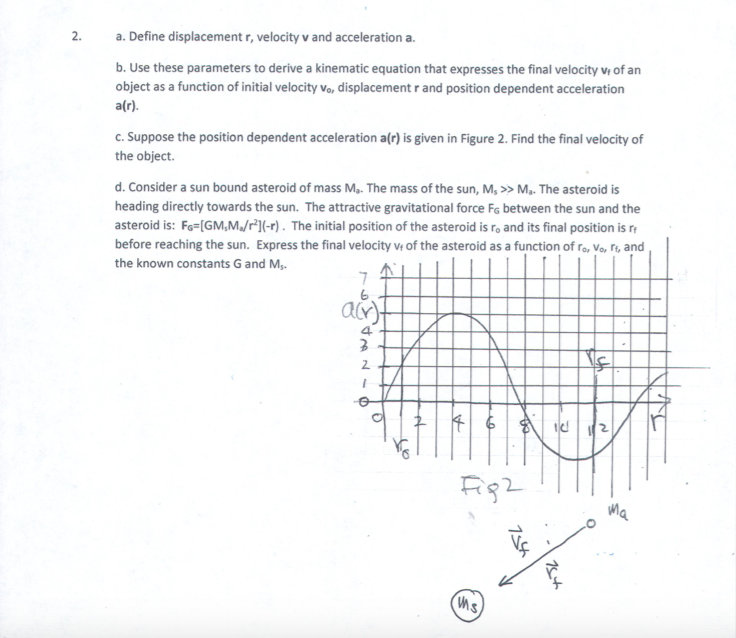2. a. Define displacement r, velocity v and acceleration a b. Use these parameters to derive a kinematic equation that expresses the final velocity vi of an object as a function of nitial velocity Vo, displacement r and position dependent acceleration a(r). C.Suppose the position dependent acceleration a(r) is given in Figure 2. Find the final velocity of the object d. Consider a sun bound asteroid of mass Ma. The mass of the sun, M,>>Ma. The asteroid is heading directly towards the sun. The attractive gravitational force Fs between the sun and the asteroid is: Fo IGM,M/r1l-r). The initial position of the asteroid is ro and its final position is r before reaching the sun. Express the final velocity of the asteroid as a function of ro, Vo, ri, and the known constants G and M 6 4. 2. 2
2. a. Define displacement r, velocity v and acceleration a b. Use these parameters to derive a kinematic equation that expresses the final velocity vi of an object as a function of nitial velocity Vo, displacement r and position dependent acceleration a(r). C.Suppose the position dependent acceleration a(r) is given in Figure 2. Find the final velocity of the object d. Consider a sun bound asteroid of mass Ma. The mass of the sun, M,>>Ma. The asteroid is heading directly towards the sun. The attractive gravitational force Fs between the sun and the asteroid is: Fo IGM,M/r1l-r). The initial position of the asteroid is ro and its final position is r before reaching the sun. Express the final velocity of the asteroid as a function of ro, Vo, ri, and the known constants G and M 6 4. 2. 2
College Physics
1st Edition
ISBN:9781938168000
Author:Paul Peter Urone, Roger Hinrichs
Publisher:Paul Peter Urone, Roger Hinrichs
Chapter4: Dynamics: Force And Newton's Laws Of Motion
Section: Chapter Questions
Problem 45PE: Integrated Concepts A large rocket has a mass of 2.00106 kg at takeoff, and its engines produce a...
Related questions
Question

Transcribed Image Text:2.
a. Define displacement r, velocity v and acceleration a
b. Use these parameters to derive a kinematic equation that expresses the final velocity vi of an
object as a function of nitial velocity Vo, displacement r and position dependent acceleration
a(r).
C.Suppose the position dependent acceleration a(r) is given in Figure 2. Find the final velocity of
the object
d. Consider a sun bound asteroid of mass Ma. The mass of the sun, M,>>Ma. The asteroid is
heading directly towards the sun. The attractive gravitational force Fs between the sun and the
asteroid is: Fo IGM,M/r1l-r). The initial position of the asteroid is ro and its final position is r
before reaching the sun. Express the final velocity of the asteroid as a function of ro, Vo, ri, and
the known constants G and M
6
4.
2.
2
Expert Solution
This question has been solved!
Explore an expertly crafted, step-by-step solution for a thorough understanding of key concepts.
This is a popular solution!
Trending now
This is a popular solution!
Step by step
Solved in 5 steps with 4 images

Recommended textbooks for you

College Physics
Physics
ISBN:
9781938168000
Author:
Paul Peter Urone, Roger Hinrichs
Publisher:
OpenStax College

University Physics Volume 1
Physics
ISBN:
9781938168277
Author:
William Moebs, Samuel J. Ling, Jeff Sanny
Publisher:
OpenStax - Rice University

Classical Dynamics of Particles and Systems
Physics
ISBN:
9780534408961
Author:
Stephen T. Thornton, Jerry B. Marion
Publisher:
Cengage Learning

College Physics
Physics
ISBN:
9781938168000
Author:
Paul Peter Urone, Roger Hinrichs
Publisher:
OpenStax College

University Physics Volume 1
Physics
ISBN:
9781938168277
Author:
William Moebs, Samuel J. Ling, Jeff Sanny
Publisher:
OpenStax - Rice University

Classical Dynamics of Particles and Systems
Physics
ISBN:
9780534408961
Author:
Stephen T. Thornton, Jerry B. Marion
Publisher:
Cengage Learning

Physics for Scientists and Engineers: Foundations…
Physics
ISBN:
9781133939146
Author:
Katz, Debora M.
Publisher:
Cengage Learning